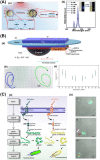Biocompatible micromotors for biosensing
- PMID: 36044082
- PMCID: PMC9428376
- DOI: 10.1007/s00216-022-04287-x
Biocompatible micromotors for biosensing
Abstract
Micro/nanomotors are nanoscale devices that have been explored in various fields, such as drug delivery, environmental remediation, or biosensing and diagnosis. The use of micro/nanomotors has grown considerably over the past few years, partially because of the advantages that they offer in the development of new conceptual avenues in biosensing. This is due to their propulsion and intermixing in solution compared with their respective static forms, which enables motion-based detection methods and/or decreases bioassay time. This review focuses on the impacts of micro/nanomotors on biosensing research in the last 2 years. An overview of designs for bioreceptor attachment to micro/nanomotors is given. Recent developments have focused on chemically propelled micromotors using external fuels, commonly hydrogen peroxide. However, the associated fuel toxicity and inconvenience of use in relevant biological samples such as blood have prompted researchers to explore new micro/nanomotor biosensing approaches based on biocompatible propulsion sources such as magnetic or ultrasound fields. The main advances in biocompatible propulsion sources for micro/nanomotors as novel biosensing platforms are discussed and grouped by their propulsion-driven forces. The relevant analytical applications are discussed and representatively illustrated. Moreover, envisioning future biosensing applications, the principal advantages of micro/nanomotor synthesis using biocompatible and biodegradable materials are given. The review concludes with a realistic drawing on the present and future perspectives.
Keywords: Biofluid; Biomedical analysis; Biosensing; Micromotors; Propulsion.
© 2022. Springer-Verlag GmbH Germany, part of Springer Nature.
Conflict of interest statement
The authors declare that there is no conflict of interest.
Figures





References
-
- Jurado-Sánchez B, Wang J. Micromotors for environmental applications: a review. Environ Sci: Nano. 2018;5:1530–1544. doi: 10.1039/C8EN00299A. - DOI
-
- Fernández-Medina M, Ramos-Docampo MA, Hovorka O, Salgueiriño V, Städler B. Recent Advances in Nano- and Micromotors. Adv Funct Mater. 2020;30(12):1908283. doi: 10.1002/adfm.201908283. - DOI
-
- Wang J. Nanomachines: Fundamentals and applications. 2013: Wiley. ePDF ISBN 978-3-527-65148-1.
Publication types
MeSH terms
Substances
LinkOut - more resources
Full Text Sources
Miscellaneous

